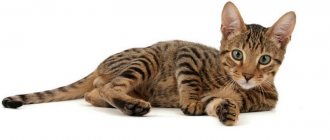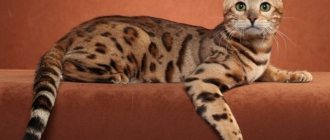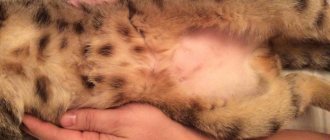The serval or bush cat is one of the few members of the cat family with roots in the wild. Despite this, he can become a devoted and affectionate pet if he is raised from an early age and buys a kitten exclusively from professional breeders. You can tell a lot of interesting and educational things about this exotic breed.
Origin story
Africa, as well as partly Egypt, can be considered the homeland of wild Servals. Since ancient times, people began to tame this animal, which is due to its small size. Such cats were especially respected in Egypt due to their hunter's instinct. The appearance of a Serval in some place guaranteed the disappearance of rodents and snakes.
If previously they lived throughout the African continent, now their range has narrowed to the southern continent (mainly Tanzania).
The first mention of the serval dates back to 1765. This was the name of the pet of the Royal Menagerie of Versailles, as the scientist Schreber described in his writings. The unusual nature of the animal was its non-standard size and remarkable color (clear spots and stripes could be seen on a golden background).
The serval is colloquially called the bush cat. The animal owes this nickname to its way of life. Animals try to spend most of their time in dense bushes, hiding from large predators. Also, such camouflage helps to successfully hunt small game.
They prefer to hide in bushes
It was registered as a domestic breed in the 19th century. Since keeping wild pets requires considerable expenses, only wealthy people kept them. Also, a Serval in the house was a sign of good taste, prosperity and greatness of the owner himself. Outwardly, a wild animal is practically no different from a domesticated one, the difference is in habits.
What to feed a serval
The serval needs to be fed in such a way that it does not even think about yearning for the African savannah. In the wild, most of the predator's diet comes from rodents and birds. The minority consists of snakes, lizards, and insects. Of course, you don’t have to catch grasshoppers for your cat; it’s enough to create the right menu of meat (beef, veal), food mice, rats and poultry. As a compliment from the cook, you can offer the animal quail eggs and offal. Vitamin and mineral supplements must be included in the diet. Water should always be freely available.
Brief description of the breed
| Breed name | Serval (Bush cat) |
| Family | Felines |
| Where does the breed come from? | Africa |
| When did the breed originate? | 1986 |
| Lifespan | 15-20 years |
| Weight of an adult cat | From 9 to 19/from 9 to 12 kg |
| Height | 40-65 cm |
| Body length including tail | 180-185 cm |
| The cost of a purebred kitten | 200-500 thousand rubles. |
Breed characteristics
A brief description of the Serval breed was compiled based on expert assessments from the website Usatik.ru and reviews from owners. The indicators are average and may not be suitable for an individual representative. Please note that each cat is individual.
| Character trait | Rating on a five-point scale |
| Attitude towards children | 4 |
| Interaction with strangers | 3 |
| Health | 4,5 |
| Playfulness | 5 |
| Intellectual capabilities | 5 |
| Attachment to home and family | 5 |
| Conflict | 0 |
| Difficult to care for | 1,5 |
| Predisposition to shedding | 0,5 |
| Cost of a kitten | 5 |
| The need for constant contact with others | 3 |
| Aggressiveness | 3 |
| Cleanliness | 4 |
| Dimensions | 5 |
| Picky eating | 3 |
Scientific classification
| Kingdom | Animal |
| Family | Felines |
| Subfamily | Small cats |
| Type | Chordata |
| Class | Mammals |
| Subclass | Animals |
| Squad | Predators |
| Infraclass | Placental |
| Genus | Servals |
| View | Bush cat |
| Subspecies | Domestic cat |
Appearance
Sexually mature Servals are graceful, active animals of fairly substantial size. The breed standard was approved in 2001 and has not changed to this day.
Externally, the cat is similar to a cheetah, but with a shorter tail. But he has the largest ears and long legs that are only found among representatives of the cat family.
Servals can jump very high
Dimensions
Servals are impressive with their size
It's hard to call it a miniature cat. Adult boys weigh about 18-19 kg, girls - about 13 kg. The body length reaches 60 cm (from the shoulder area to the tail) with a height at the withers of 55-65 cm.
Servals are taller than Caracals (their ancestors) with the same body weight.
Anatomy
Anatomical features according to the international standard:
| Body type | Strong, muscular, fit. The body is slightly elongated. |
| Head | Small, triangle shaped. The chin has clear outlines. |
| Limbs | Long, slender, with well-developed muscles. The front legs are apparently shorter than the hind legs. |
| Neck | Elongated, graceful. |
| Ears | Vertically placed, large-scale, close to each other. On the back side there are white stripes, otherwise called “eyes”. It is to them that kittens orient themselves in the dark in order to keep up with the mother cat. |
| Eyes | Medium in size, round in shape, yellowish or greenish in color. |
| Tail | Long, but not particularly thick. Compared to other parts of the body, the fur on it is fluffier. |
| Wool | Short, tough, shiny. It is in close contact with the body. There is no undercoat. |
Colors
The main color of Servals varies from sand to deep copper with dark spots and stripes. The back is darker, but the belly is lighter - from cream to pure white. Each individual has its own pattern regarding the size and location of spots and stripes.
Interesting! Previously, Servals with large and small spots were considered different species. High in the mountains of East Africa live completely black Servals (Melanists), which were also classified as a separate category. But albinos with a silver pattern were bred by breeders.
The spots on the body of the animal are close to a round shape, and closer to the rear they extend vertically and ring the tail. Its tip is completely black. The ears are separated by a white border, and their surface at the back is charcoal.
Popular serval colors
Servals are tall and slender animals with noticeably large ears. Proportional to their body size, they have the longest ears of any wild cat. The back is darker. The base coat color is sand to copper with black or dark brown spots and a striped pattern. The belly is light beige to white. The pattern is unique for each individual.
Black spots and stripes on the body vary in size and location for each individual. Individuals living in African grasslands have larger spots than those found in forests. The markings run from the top of the head between the ears and continue down the back, breaking into four distinct lines. Having reached the shoulders, the lines break and are scattered into spots along the same path of the stripes.
Interesting fact: In the early 19th century, taxonomists believed that small-spotted and large-spotted servals were different species. In the highlands of East Africa, such as the Aberdare Mountains in Kenya, there are also all-black servals, which were also originally considered a separate species. Most of these melanists were seen at altitudes from 2440 m to 2745 m. But snow-white individuals with silver spots were bred by breeders.
Reaching the rear, the spots extend perpendicularly and form rings on the tail. The tip of the tail is black. The back of the ears is black with a white line between them. Melanistic servals are occasionally observed. The Serval has great individual differences. For example, there are servals with very small spots, while others have large spots.
Character traits
Despite the fact that the Serval cat is a domestic cat, its character is not sweet. Therefore, we must put up with many manifestations and not try to change them abruptly, but still correctly correct them. Otherwise, the pet will feel its power and show itself in all its glory.
By nature, these African cats are timid and rather shy, but extremely active and mischievous. They love to play, run and jump. They cannot be prohibited from doing this, since activity is inherent in them by nature. In the wild world they are accustomed to hunting birds, overtaking them at a height of up to three meters. So domesticated individuals also have this habit.
You must be prepared for the fact that in the process of conquering the peaks, valuable things around the house may suffer (it is better to remove everything in advance).
Carefully! Servals cannot be played with with your hand or foot. This can provoke the animal to attack using its claws and teeth. If the kitten’s bite is not particularly sensitive, then such a lunge from an adult Serval can lead to serious injury. Therefore, during active pastimes, they use special toys for pets.
They are also compared to dogs because of their acutely developed sense of devotion to their owner. In case of danger, the cat will be the first to rush to defense. This also applies to all other family members. But establishing contact with an African native is much more difficult than with an ordinary domestic cat. It takes a lot of effort until the kitten gets used to its owner. But then the efforts will pay off handsomely - you will not find a more faithful friend and companion.
The bush cat is quite a benevolent creature
In general, these cats are quite friendly and extremely inquisitive. There will be no corner in the house that will go unnoticed.
It is worth noting some other features of Serval behavior:
- Feeling danger, the cat tries to run away. If you start to catch up, she will think that they want to harm her. It is wiser to wait until the pet calms down and comes up on its own. You can try to bring him back through gentle persuasion, attracting him with his favorite toy or treat.
- It is unacceptable to leave the Serval alone with children. At this time, you need to stand nearby and control the communication. Since the cat’s ancestors are predators, any encroachment on their person can be perceived as a threat. Then there is a high risk that the animal will show aggression towards the child. Or your pet will develop a fear of children that will remain forever.
If cats are treated with respect and care, they will not offend anyone.
Attitude towards people
Adult cats are distrustful and wary of strangers in the house. At the sight of a stranger, the Serval immediately retreats and hides in some secluded place. Until the guests leave, he will not come out.
On a note! Do not try to forcefully pull the Serval out for display. This will only frighten your pet, which can harm him emotionally. Such actions are fraught for the owner with loss of trust on the part of his pet.
Attitude towards other animals
They get along with other pets without problems. However, at first they need time to get used to them. But then they enjoy playing and running together. Problems can only arise when living next to small pets (birds, hamsters). The cat may mistake them for toys and cause harm.
Character
Domestic cats of this breed have a “slightly doggy” character. They love to hunt, are trainable and jump very high. Just imagine, a serval’s jump reaches three meters! A serval kitten needs to be walked constantly; they love walks in the fresh air. Serval kittens are very playful and inquisitive. They explore the most secret corner of your apartment or house. To prevent the serval from going wild, it is necessary to educate it and show it who is boss. From early childhood, accustom your pet to order and teach him what he can and cannot do.
Domestic servals are kind and simple-minded, they love communication and “talk” with pleasure.
Don't forget that big cats can damage some utensils in the house, so you should remove anything that can break from accessible places.
Animal health
Domestic Servals, like wild ones, have good health. They are not characterized by diseases of genetic origin, since different breeds were not involved in the crossing. It is important to constantly monitor your pet’s condition and adhere to safety precautions. Kittens are extremely active. Therefore, until they reach six months (the period of active growth), make sure that they do not jump from great heights. The skeleton, which has not yet formed, is especially susceptible to injury.
Representatives of this breed sometimes experience disturbances in the gastrointestinal tract. If your kitten has persistent diarrhea, do not delay a visit to the veterinarian. Otherwise, dehydration is possible in literally a short period of time.
In general, proper nutrition will guarantee the health and well-being of your pet.
How long do domestic servals live?
In the wild they live for about 12-13 years. But domestic cats, which are properly cared for, provided with a balanced diet and there is no threat from large predators, can easily live up to 20 years.
Serval breeding
In its natural habitat, the African serval leads a predominantly solitary lifestyle, with the exception of the mating season. Essentially, males are polygamous and their territories are available to an unlimited number of females during mating. Despite the fact that animals do not have a clear interval for reproduction, it most often occurs in the spring. The “bride” begins to court the potential partner, and very patiently. Then comes estrus, which lasts no more than a day.
Breeding in captivity is a complex process and requires a professional approach. The female bears the offspring for 10-11 weeks, resulting in the birth of no more than three kittens weighing about 200 grams. In the first ten days they increase in size almost 2-3 times. Permanent fangs grow by six months. And puberty occurs in the interval of 19-24 months.
For your information! Every breeder who undertakes the breeding of Servals accomplishes a feat. It is believed that these animals do not reproduce in captivity, but in practice this is real. During the mating season, the cat becomes extremely anxious, active and can even injure animals in the neighborhood. There is a high probability that the offspring will be born underdeveloped and will need outside help.
If a mother cat is carrying hybrid babies, then after they appear, she can crush them. The weight of such newborns is no more than 100 grams. It is worth noting that males born from mating Serval with other breeds of cats remain sterile for several subsequent generations.
Serval diet
Servals need more nutrients than domestic cats. In the wild, servals feed on rodents and small animals, as well as birds. In captivity, the diet must be adequate nutrition. They must receive sufficient calcium (54 mg per animal).
The Serval diet consists of poultry bones, meat and fish with added vitamins intended for wild cats. This includes all shapes of chicken (necks, thighs, wings and stuffing), turkey necks and ground beef, any cut of beef and ground beef, and canned fish such as tuna, salmon, mackerel. You can also offer delicacies such as cheese, beef jerky, fruits such as strawberries, cherries, oranges and bananas, lettuce and tomatoes, and macaroni and cheese.
Serval feeding stages by age:
- Feeding kittens consists of high-quality crushed food. Kittens under 6 months of age will need mince, offered in combination with wet food. A mixture of ground raw turkey mixed with powdered dry IAMS works well for small kittens. You may want to feed them regular cat food, but only use premium cat food that is 75% meat;
- By the time the serval is six months old, it can be fed a combination of dry and wet food;
- As your kitten begins to mature, you can give him a chicken leg or neck. When the serval reaches maturity, he can be offered raw chicken, bones and all. Do not feed your animal cooked meat. Most meat contains high levels of phosphorus, and if not eaten with the required amount of calcium, it will lead to small or brittle bones and other problems. Exotic cats need the correct ratio of the two minerals to use calcium for bone growth. The serval should eat as much as it wants, but don't leave food out for more than a couple of hours;
- An adult eats from 0.5 to 1.4 kg of meat per day. Serval cats can eat a lot in one day and less the next day, but if the pet's appetite disappears for a long time, the animal should be taken to an exotic animal veterinarian. Vitamin supplements are required. Feeding grass once a week for the digestive system;
- Make sure they have enough clean water to drink. Place several bowls of water around the house. Animals love to play in water, so make sure toilets are closed.
Interesting Facts
Some interesting facts about African cats:
- Their long legs earned them the nickname “giraffe cat.” This structural feature is due to the highly elongated metatarsal bones of the limbs.
- Among all representatives of the cat family, it has the largest ears. They are crescent-shaped, erect, black on the back and have white markings.
- They can easily overcome heights of 3 meters or more. They jump without a run, pushing off with their powerful hind legs.
- Males and females tend to mark their personal territory by spraying urine and rubbing it in with their claws. Males do this more intensely – up to 45 times per hour.
- From time to time there are cat fights. When threatened, the animal looks very intimidating: straightened ears, arched back, bared fangs. At the same time, they constantly shake their heads. When the situation worsens, the animal pounces with its forelimbs and begins to bark and growl.
- They can purr, chirp, hiss, click and make other unusual sounds. Besides that, they are like dogs, they bark.
The name of the cat comes from the Latin word, which means “wolf-deer”.
Myths about the danger of Servals
Domestic Servals are not dangerous to humans if you treat the animal with respect.
Many people are wary of this breed of cat because of common myths about the dangers of keeping them near humans. It is believed that savages cannot be tamed. This is the opinion of those who have not actually interacted with domesticated animals, not aviary animals.
To explain briefly, the domestic Serval cat is no more dangerous than a medium-sized dog. Even in the wild, these animals hunt mainly small animals, and in front of a more formidable opponent they give in and, at most, hiss to intimidate, but do not attack themselves. The exception will be when the mother stands up to protect her offspring. In fact, these are affectionate and friendly creatures, capable of interacting with humans without conflict.
It is also necessary to take into account that Servals do not get along well in families with small children, who perceive the animal as a toy and terrorize it (pulling its tail and ears, shoving it, etc.). They also cannot tolerate loud noises, and children tend to scream. If a child understands how to behave correctly with such a pet, communication problems will not arise.
Advice! When choosing a kitten, pay attention to its behavior. If he aggressively hisses and bites, then obviously in the future he will not become an easy-going cat. It is better to refuse such an instance immediately. It is better to take the baby away from the mother cat when he is 1.5-3 months old.
Keeping a serval at home
It is recommended to have a Serval only to live in a private house with an attached enclosure and free access to it from a separate cat room. It is important that the animal always has a place where it can hide or simply retire to rest. Sometimes servals are brought into apartments, but this is not the best option. Servals need a lot of exercise to stay fit and healthy.
Servals do not need special care, they do not have a specific odor and are very clean.
Not so long ago, they didn’t even suspect the possibility of professional fur care, and therefore got used to taking care of their personal hygiene themselves. True, many owners, in order to maintain a neat appearance during seasonal molting, comb their cats using natural bristle brushes or special mittens. Caracals can be offered bathes as fun, but they do not need to be washed with professional shampoos or conditioners. Servals go to the toilet using a potty with litter, which differs from a cat's only in size.
It is also worth considering that with the onset of puberty, servals begin to actively mark their territory. In this regard, castration/sterilization is recommended for animals not for breeding.
Video about keeping a domestic serval:
Features of education
In raising a serval, you will have to show considerable patience, and it is important to take into account a lot of features and not neglect the advice of breeders.
Serval kittens love to chew everything, in this they are similar to puppies. Many toys will help distract your baby's attention from valuables. to. It is recommended to spray electrical wires and electrical appliances with special cat sprays from the “anti-rodent” series, which are sold in regular pet stores. Under no circumstances should you scream or hit a cat; it may not forgive you for this. In addition, a clear command “no!”, supported by water from a spray bottle, will be more effective. You should not play with your baby’s hands or feet; as he grows up, he will perceive them as his toys and may scratch, bite or attack from an “ambush”.
Leash training should be done as early as possible. On the street, a kitten should feel absolutely safe next to its owner; this is the main key to success.
Owner reviews
Olga: I professionally breed Serval cats. I would like to assure you that these are smart and elegant animals. My students are very smart. They instantly understand commands and execute them. The main thing is to say in a confident but calm voice: walk, lie down, eat, come to me, toilet - and cats do everything the first time. Our Africans do not need a separate place to rest (although they do have beds), since they always go to bed next to us. This breed can be called imperial!
Anastasia: At the beginning, as soon as a kitten appeared in our house, he scared me. He had just turned 5 months old, and the baby hissed and growled incessantly whenever my husband or I tried to approach him. But we were patient and began to establish contact with the savage. As a result, the efforts were crowned with success - the new resident stopped being afraid of us and overreacting. Now this tomboy no longer hides in secluded places, but frolics openly. We often take him on walks together, which brings real pleasure to everyone.
Oleg: We consider Astena (that’s what we named the Serval kitten) to be our child. We constantly pamper her, let her do a lot, and she uses it successfully. Not so long ago, with my own hands, I equipped a large playing town for my pet instead of a house. The complex is multi-level, where the cat can hone his hunting skills to his heart's content. We also take our Asta on trips, where there are no problems with her. She calmly walks nearby on a leash and quickly gets accustomed to another tray.
Andrey: A friend gave me a Serval kitten as a gift. At first I thought it was a small cheetah, it was very similar in appearance. He named him Whiskas. Now he is already a year old. He turned into a graceful animal with long legs - I especially like this feature. By nature, he is very playful, mischievous and extremely active. He is always close to me, we even sleep together.
Antonina: Before getting a cat of this breed, I studied a lot of information and reviews from happy owners. But there were doubts, since it is a predator by nature, and there were concerns, since we have children. But the desire prevailed, and we decided to buy such a pet. Serval has been living in the house for a year now, so far everything is going well with communication. Maybe his character will change with age, but now he is calm and friendly.
Character and habits of servals
In the wild, cats must be smart to survive. Natural selection allowed the smartest and most dexterous individuals to remain alive, and you will understand this when the serval suddenly learns to open doors. The animal has a shy and fearful behavior, but it is very active and playful.
Some of the natural tendencies of servals are:
- One reasonable factor is that feral cats will run away from danger. If a serval is chased, the animal will think that you are trying to harm it. There is no need to follow this cat unless absolutely necessary. But even in an emergency, you should try to get your serval to come to you by cooing or talking to your baby serval, playing with his favorite toy, or offering him a treat. You will be more successful;
- Adult servals are wary of strangers. In the wild, when an unknown male/female feral cat enters another's territory, a challenge usually occurs, or one of them runs away. When visitors come to you, the serval may hide and not come out until he is sure that the guests have left. Do not try to exhibit a serval for show. This will frighten your pet and may cause emotional/physical harm. They may start to distrust you;
- Be sure to keep an eye on children who are near the serval. If children harm the animal, it may develop a fear of children and servals may attack the offenders. This fear of children will remain with them forever. They are very smart and can distinguish the voice of a child from the voice of an adult;
- Servals generally love other animals. They can play with almost any animal once they get used to each other. However, as your cat gets older, you need to be careful when introducing her to a new small pet. They may think that they are chewing toys and causing pain to the baby.
Don't forget that although the animal lives next to you, it should also have its own cozy nest. For this reason, it is useful for him to create a comfortable, soft place where he can retire, sleep or just lie down.











